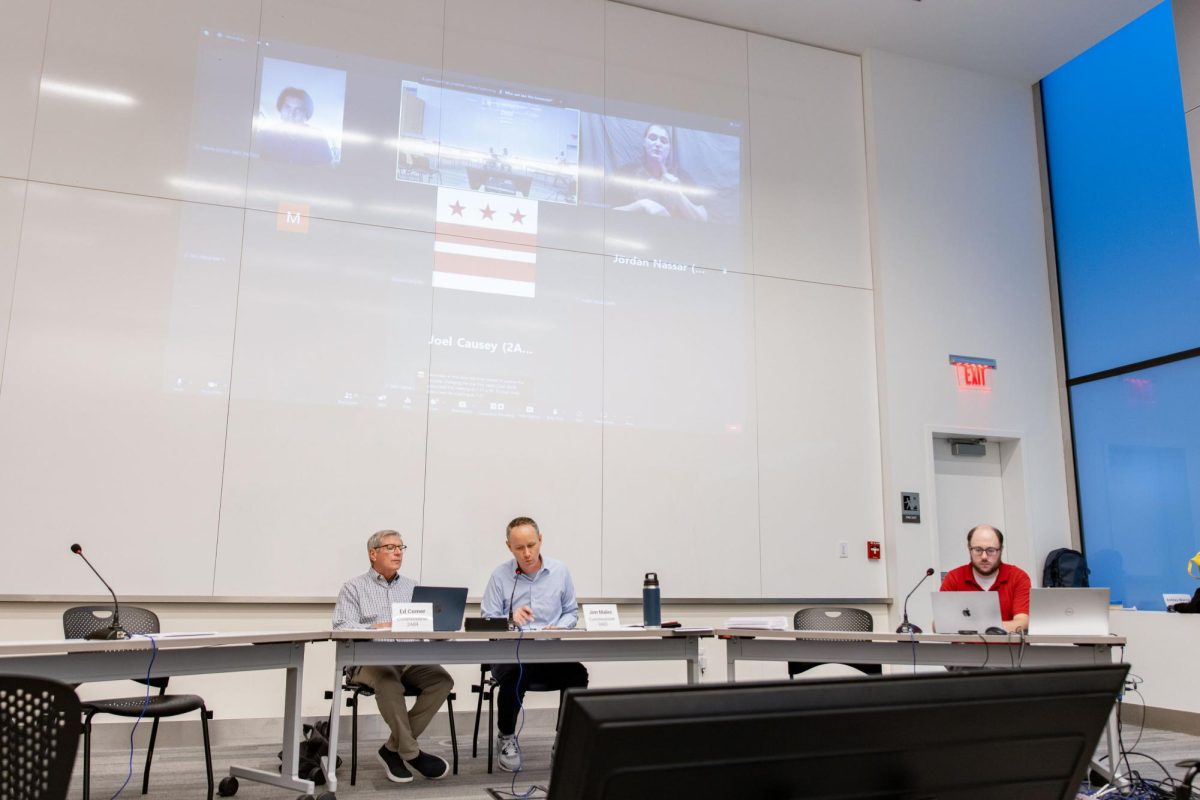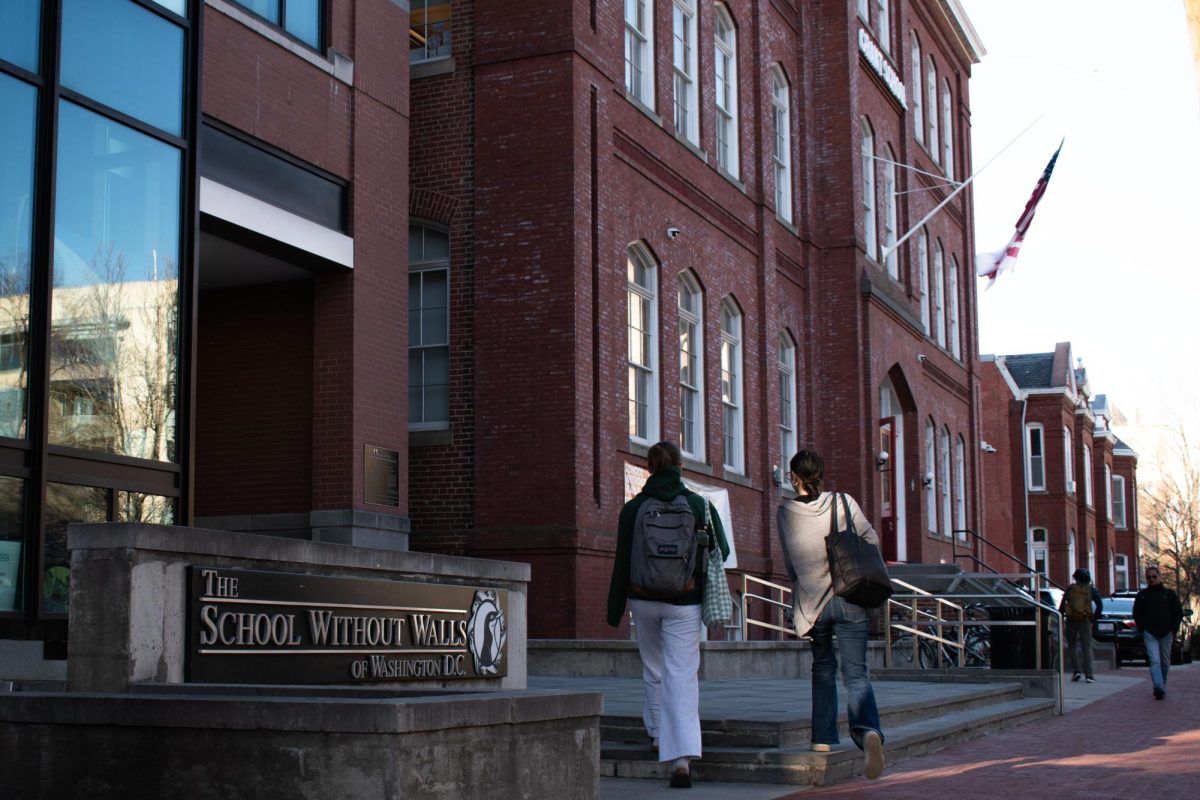A local governing body approved GW’s request to restrict the public’s access to District House after the implementation of a new dining system this fall during a monthly meeting Wednesday.
The Foggy Bottom and West End Advisory Neighborhood Commission unanimously voted to change the building’s zoning from general public retail to restricted University dining, pushing ahead GW’s plans to build a dining hall in the basement of District House before opening the space this fall. Del. Eleanor Holmes Norton, D-D.C., also answered questions from commissioners, and the University provided updates on its COVID-19 isolation policy at the meeting.
Here are a few of the meeting’s highlights:
ANC endorses District House dining hall plan
The ANC unanimously supported the University’s application to modify zoning at District House, sending the request to the D.C. Zoning Commission for final approval.
Karen Zinn, GW’s associate vice president for business services, said GW requested the zoning modification so the University could transition to a residential dining model with a new dining hall in District House restricted to University community members this fall. GW will also open dining halls in Shenkman and Thurston halls in the fall as part of a new unlimited dining system with all-you-can-eat meal access mostly in place of GWorld vendors previously housed in residence halls.
“For community building, for the safety of our students, we want the dining program to be exclusive to the University community, not have the program open to the public,” Zinn said during the meeting. “What that means for District House is a change in zoning.”
She said the public will still have access to restaurants on campus, like Panera and Chick-fil-A in the University Student Center, as well as dining options in Western Market and new spots set to open this year in the 2100 Penn complex. Zinn presented preliminary floor plans for the renovated District House food court, which would intersperse the floor with seating and vendors, like “Piccola Italia” and “Tú Taco.”
“It will look like it’s retail, but it functions as all-you-care-to-eat,” she said. “It means that students can come in, they can stay, they can fill their plates.”
[gwh_image id=”1156126″ credit=”MEDIA CREDIT: COURTESY OF GEORGE WASHINGTON UNIVERSITY” size=”embedded-img” align=”none”]Officials presented their proposed concept for the District House dining hall that’s set to open this fall under a new unlimited dining system. The ANC approved the University’s application to remove public access from the site.[/gwh_image]
Commissioner Trupti Patel relayed concerns from her constituents about the accessible and affordable food vendors that will leave District House to make room for the new dining layout. Kevin Days, the University’s director of community relations, said the moves are meant to address food insecurity facing students, which the University considers a top priority.
“The University is not interested in reducing public facilities for the community,” Days said. “What we’re doing is transforming them and reallocating our space to serve our primary function, which is to serve the GW student population.”
GW shares COVID–19 isolation protocol update
Days also delivered updates to commissioners about Mark Wrighton’s arrival as interim University president and GW’s handling of the Omicron variant after the University community returned to campus earlier this month. Days said more than 500 people tested positive before returning to Foggy Bottom, delaying their return to campus.
He also confirmed that officials reserved 250 beds at the Yours Truly Hotel until Feb. 26 to serve as extra COVID-19 isolation housing for students if on-campus isolation housing exceeds full capacity. Days said students isolated in the hotel use their own elevator, receive food deliveries and return to campus with transportation provided after their 10-day stay.
Days said officials followed COVID-19 protocol set by D.C. Health in their decision to maintain GW’s 10-day isolation period despite guidance from the Centers for Disease Control and Prevention recommending five days of isolation for asymptomatic COVID-19 cases. He said GW officials are continuing to conduct contact tracing for members of the University community who test positive for COVID-19, while D.C. officials alert potential close contacts who are not affiliated with GW.
“We are seeing some promising numbers and positivity rate – the positivity rate seems to be heading in the right direction,” Days said. “And we are pretty confident that once we move through this spike period, we’ll be able to go back to fully isolating our students on campus.”
Holmes Norton answers questions from commissioners
Holmes Norton, the District’s non-voting congressional delegate, attended the meeting to answer questions about topics like D.C. statehood and road safety.
She said she helped to defeat 20 bills in the past year that threatened to interfere with D.C.’s self-determination, including legislation targeting the District’s vaccine mandate and COVID-19 restrictions. She said Congress has treated the District like a political “football” and asserted that D.C. statehood is the primary method to prevent potentially intrusive federal policies.
“Republicans, and it is always Republicans, will continue to try to interfere with D.C. to score political points until D.C. has statehood,” she said during the meeting.
Holmes Norton answered a question from Commissioner Yannik Omictin about repeated closures of the Ellipse and Lafayette Park, which can force cyclists to take detours without protected bike lanes. She said she opposes barriers to safe transportation and announced a virtual town hall about road safety later this month.
2021 was an especially deadly year for traffic-goers in the District as traffic collisions killed 40 people on the roads of D.C. last year, the most since 2007.
“Federal infrastructure policy has long prioritized speed for motorists over the safety of people in communities that those crossroads pass through,” Holmes Norton said. “As a result, pedestrians and bicycles are often an afterthought in road design, but under the recently passed bipartisan infrastructure law, we are moving away from that.”
E Street encampment shrinks, evictions stalled
Omictin said the Office of the Deputy Mayor for Health and Human Services sent a letter to the D.C. Council last month announcing that no immediate plans were in place to evict people from the homeless encampment at 20th and E streets near campus. The message is a reversal from the city’s previous plans to close three of the city’s largest homeless encampments, including the E Street encampment, and transition unhoused residents to affordable housing through a pilot program launched last September.
The program faced harsh backlash from local activists who claimed it was not thoroughly or transparently planned and failed to connect all residents to housing options. The ANC requested the deputy mayor’s office in October to delay the encampment evictions until residents have received the opportunity to be housed under the new program.
Omictin said the letter announced that officials would also wait longer to evict an encampment at 25th Street and Virginia Avenue with similar intentions of ensuring residents found housing first.
He said the decision to stall evictions will make it easier to provide housing, an approach that he argued has already been successful, noting that the size of the E Street encampment has shrunk dramatically with only six or seven people remaining in tents at the park.
“The number of folks that live there has gone down to around six, seven, and so that is a tremendous improvement,” Omictin said. “A lot of folks are getting housing.”







